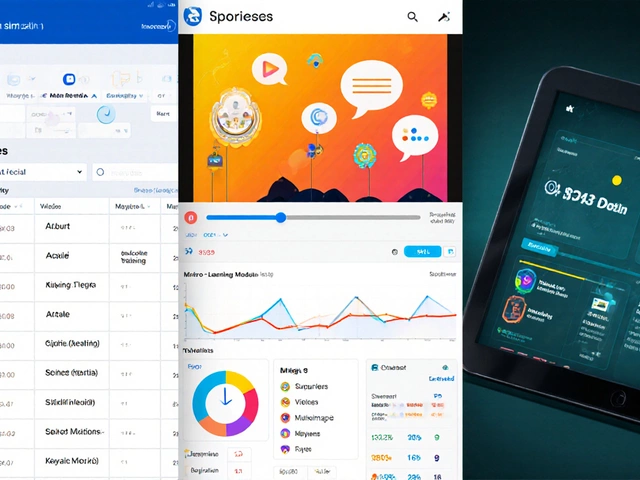eLearning Format Explorer
Select an eLearning format below to learn more about its characteristics and real-world examples.
MOOC
Massive Open Online Course
LMS
Learning Management System
Webinar
Live Online Seminar
Simulation
Interactive Simulation
Gamified
Gamified Learning
Microlearning
Short Learning Modules
When people talk about eLearning is a digital method of delivering educational content via the internet, allowing learners to access lessons, assessments, and interactive activities from any device, they often wonder what it actually looks like in practice. Below you’ll find concrete examples that show how eLearning moves from theory to everyday learning experiences.
Core Formats that Power eLearning
- Massive Open Online Course (MOOC) is a large‑scale, web‑based course open to anyone with an internet connection. MOOCs usually combine video lectures, quizzes, and peer‑reviewed assignments.
- Learning Management System (LMS) is software that hosts, tracks, and manages learner progress for corporate or academic training. Think of platforms like Canvas or Moodle.
- Webinar is a live, online seminar where an instructor presents slides or demos while participants can ask questions in real time.
- Interactive Simulation is a software model that lets learners manipulate variables to see cause‑and‑effect outcomes, often used in science or engineering training.
- Gamified Learning is the use of game mechanics-points, badges, leaderboards-to boost motivation and retention.
- Microlearning is short, bite‑size modules (usually under 5 minutes) that focus on a single learning objective.
- Blended Learning is a hybrid approach that mixes face‑to‑face classroom time with online activities.
Real‑World eLearning Examples
Seeing the formats in action helps you picture how they could fit your own learning goals. Below are some widely‑used platforms and programs that illustrate each format.
- Khan Academy is a free, nonprofit platform offering thousands of short video lessons and practice exercises, primarily in math and science. Its microlearning style lets students watch a 5‑minute video and then try related problems.
- Coursera is a MOOC provider that partners with universities worldwide to deliver full‑length courses, specializations, and even degrees. Courses blend pre‑recorded lectures, peer‑graded assignments, and optional live sessions.
- Udemy is an online marketplace where industry experts create video‑based courses on topics ranging from programming to photography. Learners purchase individual courses and study at their own pace.
- Duolingo is a gamified language‑learning app that uses points, streaks, and bite‑size lessons to keep users engaged. Each lesson lasts a few minutes, perfect for daily practice.
- Adobe Captivate Prime is an enterprise LMS that delivers onboarding, compliance, and skill‑building modules, complete with analytics for managers. It supports SCORM‑compliant content and integrates with HR systems.
- Microsoft Teams Live Events is a webinar tool that lets organizations broadcast live training to large audiences, with Q&A and polling features.
- Labster is an interactive simulation platform for science education, offering virtual labs where students can conduct experiments safely online.

How These Examples Work Behind the Scenes
Each platform relies on a combination of content creation, delivery technology, and data tracking. For instance, Coursera uses a MOOC model that bundles video lectures with auto‑graded quizzes stored in a cloud‑based LMS. Duolingo’s gamified approach feeds user actions into a recommendation engine that serves the next optimal lesson. Understanding these mechanics helps you decide which style matches your learning style or training need.
Comparison of Popular eLearning Solutions
| Solution | Primary Format | Typical Audience | Interactivity Level | Pricing Model |
|---|---|---|---|---|
| Coursera | MOOC | College students, professionals | Medium - quizzes, peer review | Free audit; $39‑$79 per month for certificates |
| Adobe Captivate Prime | LMS | Corporate employees | High - SCORM, branching scenarios | Subscription per user, starting $15/month |
| Duolingo | Gamified app | Language learners of all ages | High - points, streaks, adaptive lessons | Freemium; $12.99/month for ad‑free |
| Labster | Interactive simulation | STEM students, university labs | Very high - 3D lab manipulation | Institutional license, custom pricing |
Benefits of Using Real‑World eLearning Examples
- Flexibility: Learners can study on a schedule that fits work or family commitments.
- Scalability: One course can reach thousands without additional instructor time.
- Data‑driven insights: Platforms track completion rates, quiz scores, and engagement, letting educators refine content.
- Cost efficiency: Many options are free or low‑cost compared with traditional classroom expenses.
- Personalised pathways: Adaptive algorithms suggest the next lesson based on performance.
Choosing the Right eLearning Example for Your Needs
- Identify the learning goal. Is the aim to earn a credential, acquire a specific skill, or supplement classroom teaching?
- Match the format. For deep academic subjects, a MOOC or LMS works best. For quick language practice, a gamified app shines.
- Consider the audience’s tech comfort. Older learners may prefer straightforward video lessons, while digital natives enjoy simulations.
- Check accessibility. Ensure subtitles, screen‑reader compatibility, and mobile‑friendly design.
- Evaluate budget. Free platforms like Khan Academy cover many basics; corporate training may need a paid LMS.
Next Steps and Troubleshooting
If you’re just starting, pick a free microlearning platform such as Khan Academy to get a feel for online study. Should you hit technical issues-like videos not loading-try clearing browser cache, switching browsers, or checking your internet speed. For corporate roll‑outs, begin with a pilot group using a trial LMS to gather feedback before a full launch.
Frequently Asked Questions
What sets eLearning apart from traditional classroom teaching?
eLearning delivers content digitally, letting learners access materials anytime, anywhere. It also provides data tracking, adaptive pathways, and usually lower costs than in‑person classes.
Can I earn a recognized certificate through an eLearning example?
Yes. Platforms like Coursera, edX, and Udacity partner with universities and industry leaders to issue accredited certificates and even full degrees.
Do I need high‑speed internet for all eLearning formats?
Most video‑based courses work well on broadband, but microlearning apps like Duolingo are designed to run on slower connections. Simulations and live webinars benefit from faster speeds.
How can I measure the success of an eLearning program?
Key metrics include completion rate, assessment scores, learner satisfaction surveys, and post‑training performance improvements. LMS dashboards typically display these stats automatically.
Is eLearning suitable for hands‑on skills like laboratory work?
Interactive simulations such as Labster replicate lab environments virtually, allowing safe practice of experiments. While they don’t replace physical labs entirely, they provide valuable preparation.











